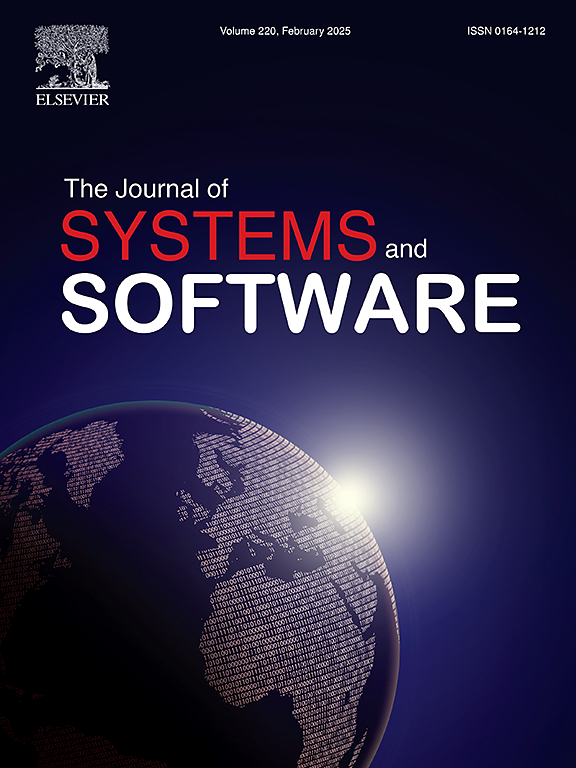Awareness support in collaborative programming tools: An evaluation based on programmer's perception and eye tracking
IF 3.7
2区 计算机科学
Q1 COMPUTER SCIENCE, SOFTWARE ENGINEERING
引用次数: 0
Abstract
Groupware technology is an essential asset for organizations and a successful medium to support social meetings and teacher-learning processes when people are geographically distributed. Computer programming is a domain that can take advantage of the Collaborative Work paradigm and of this technology. However, to be truly effective, groupware systems must provide suitable awareness support, i.e., be capable of informing users of the activity taking place and of the team outcome, so that they can build a setting for their work. The study of awareness mechanisms and their influence on collaborative programming processes is an open research question. In this context, this article contributes an experimental study to evaluate the mechanisms to support coordination, communication, and awareness of COLLECE, a distributed group programming system rich in awareness support. This study brings as a novel approach the combination of subjective and objective information sources, specifically eye tracking techniques, and incorporates a heuristic evaluation of awareness support based on a well-known framework. Thanks to this experiment, we have been able to verify that this blended approach, in which users participate intensively, provides a more comprehensive and deeper assessment of awareness and other coordination and communication mechanisms, and thus a better understanding of how their use can influence the collaborative programming process and outcome (program or piece of software). The study has revealed strengths, weaknesses and opportunities for improvement of the evaluated system, and has yielded concrete results as to which are the most useful awareness components of the user interface not related to the activity supported by the system (programming), these being the traffic lights; the easiest to use, such as the session panel; or the components that impose a greater cognitive load, such as the multi-scrollbar. Regarding the relationship between the supported awareness dimensions and the quality of the collaboration outcome (computer program), the results point to the need to adequately support the What-Artifact dimension, i.e., highlighting in which part of the shared workspace (the source code) the user with floor control is working.
协作编程工具中的意识支持:基于程序员感知和眼动跟踪的评估
群件技术是组织机构的重要资产,也是在人员分散的情况下支持社交会议和师生学习过程的成功媒介。计算机编程是一个可以利用协同工作范式和这一技术的领域。然而,要想真正有效,群件系统必须提供适当的感知支持,即能够告知用户正在进行的活动和团队成果,以便他们为自己的工作建立一个环境。研究感知机制及其对协作编程过程的影响是一个尚未解决的研究问题。在此背景下,本文通过一项实验研究,评估了 COLLECE(一种富含感知支持的分布式群组编程系统)的协调、交流和感知支持机制。这项研究将主观和客观信息源(特别是眼动跟踪技术)相结合,并在一个著名框架的基础上对意识支持进行启发式评估。得益于这项实验,我们得以验证,这种由用户深入参与的混合方法能够对意识及其他协调和交流机制进行更全面、更深入的评估,从而更好地理解这些机制的使用如何影响协作编程过程和结果(程序或软件)。这项研究揭示了所评估系统的优势、劣势和改进机会,并得出了具体结果,即哪些是与系统支持的活动(编程)无关的用户界面中最有用的认知组件,如交通灯;哪些是最容易使用的组件,如会话面板;哪些是造成较大认知负荷的组件,如多滚动条。关于所支持的认知维度与协作成果(计算机程序)质量之间的关系,结果表明,需要充分支持 "什么--工件 "维度,即突出显示拥有楼层控制权的用户正在共享工作区(源代码)的哪个部分工作。
本文章由计算机程序翻译,如有差异,请以英文原文为准。
求助全文
约1分钟内获得全文
求助全文
来源期刊

Journal of Systems and Software
工程技术-计算机:理论方法
CiteScore
8.60
自引率
5.70%
发文量
193
审稿时长
16 weeks
期刊介绍:
The Journal of Systems and Software publishes papers covering all aspects of software engineering and related hardware-software-systems issues. All articles should include a validation of the idea presented, e.g. through case studies, experiments, or systematic comparisons with other approaches already in practice. Topics of interest include, but are not limited to:
•Methods and tools for, and empirical studies on, software requirements, design, architecture, verification and validation, maintenance and evolution
•Agile, model-driven, service-oriented, open source and global software development
•Approaches for mobile, multiprocessing, real-time, distributed, cloud-based, dependable and virtualized systems
•Human factors and management concerns of software development
•Data management and big data issues of software systems
•Metrics and evaluation, data mining of software development resources
•Business and economic aspects of software development processes
The journal welcomes state-of-the-art surveys and reports of practical experience for all of these topics.
 求助内容:
求助内容: 应助结果提醒方式:
应助结果提醒方式:


